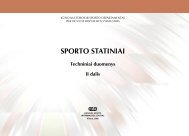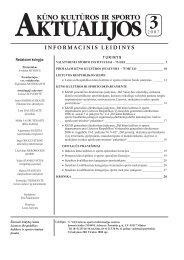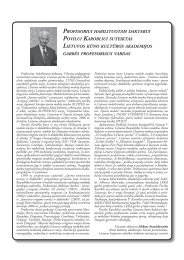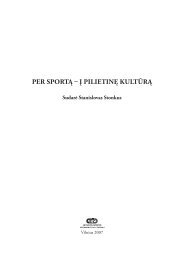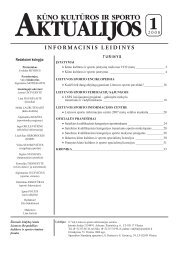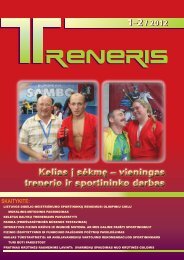Nr. 1 - Lietuvos sporto informacijos centras
Nr. 1 - Lietuvos sporto informacijos centras
Nr. 1 - Lietuvos sporto informacijos centras
Create successful ePaper yourself
Turn your PDF publications into a flip-book with our unique Google optimized e-Paper software.
2010 <strong>Nr</strong>. 1(59)<br />
61<br />
būti orientuotas į individualių gebėjimų lavinimą ir<br />
treniruotės programų tobulinimą.<br />
Išvados<br />
1. 19–22 metų trumpųjų nuotolių bėgikų specialiojo<br />
fizinio parengtumo rodikliai parengiamuoju laikotarpiu<br />
pamažu gerėjo, tačiau iki varžybų pradžios<br />
nepasiekė statistiškai patikimos ribos (p > 0,05).<br />
2. Trumpųjų nuotolių bėgikų varžybų rezultatas<br />
turi stipresnius koreliacinius ryšius su horizontalios<br />
krypties šuoliais, tačiau rezultatams įtakos turi ir<br />
vertikalūs šuoliai.<br />
Literatūra<br />
1. Bradauskienė, K. (2007). Sportininkų bėgimo greičio<br />
didinimo veiksniai ir technologijų optimizavimas: daktaro<br />
disertacija. Kaunas: LKKA.<br />
2. Cronin, J., Hansen, K., Kawamori, N., Mcair, P. (2008).<br />
Effects of weighted vests and sled towing on sprint kinematics.<br />
Sports Biomechanics, 7(2), 160–172.<br />
3. Čoh, M., Dolonec, A. (2002). Kinematic, kinetic and<br />
electromyographic characteristics of the sprinting stride<br />
of elite female sprinters. In: M. Čoh (Ed.), Application of<br />
Biomechanics in Track and Field.<br />
4. Karoblis, P. (2005). Sportininko rengimo teorija ir<br />
didaktika. Vilnius.<br />
5. Radžiukynas, D. (1997). Trumpų nuotolių bėgimo ir šuolių<br />
treniruočių teorija ir didaktika. Vilnius.<br />
6. Radžiukynas, D., Radžiukynas, D., Žilinskienė, N. (2004).<br />
Lengvaatlečių trumpųjų nuotolių bėgikų ir šuolininkų<br />
specialusis fizinis parengtumas. Ugdymas. Kūno kultūra.<br />
Sportas, 3(53), 24.<br />
7. Radžiukynas, D. (2005). Jaunųjų lengvaatlečių atranka<br />
ir rengimas. Vilnius.<br />
8. Satkunskienė, D., Stanislovaitis, A. (2004). Pasaulio ir <strong>Lietuvos</strong><br />
elito sprinterių bėgimo žingsnio kinematinių charakteristikų<br />
palyginamoji analizė. Sporto mokslas, 1, 6–13.<br />
9. Satkunskienė, D., Rauktys, D. (2007). Bėgimo<br />
palengvintomis sąlygomis poveikis skirtingo meistriškumo<br />
sportininkių bėgimo technikai. Ugdymas. Kūno kultūra.<br />
Sportas, 1(64), 36–43.<br />
10. Skernevičius, J., Raslanas, A., Dadelienė, R. (2004).<br />
Sporto mokslo tyrimų metodologija. Vilnius.<br />
11. Stanislovaitis, A., Grūnovas, A., Butkus, V. (2006).<br />
Trumpų nuotolių bėgimas. Kaunas.<br />
12. Stanislovaitis, A., Stanislovaitienė, J., Kavaliauskienė,<br />
E., Skurvydas, A., Muliarčikas, A., Dargevičiūtė, G. (2008).<br />
Didelio meistriškumo sportininkų bėgimo greičio rezultatų<br />
kaitos priklausymas nuo treniruočių krūvio. Ugdymas. Kūno<br />
kultūra. Sportas, 4(71), 98–103.<br />
13. Žilinskienė, N., Radžiukynas, D. (2003). Didelio<br />
meistriškumo šuolininkės į aukštį rengimas. Sporto mokslas,<br />
1(31), 32–36.<br />
14. Warden, P. (2001). Sprinting and hurdling. Arizona:<br />
Track & Field.<br />
Dynamics of physical development and special physical preparednes of<br />
19-22 years old short distance runners<br />
Assoc. Prof. Dr. Darius Radžiukynas, Assoc. Prof. Dr. Ramunė Žilinskienė, Augustas Četkauskas<br />
Vilnius Pedagogical University, Vilnius University<br />
Increase of sports results of the short distance runners<br />
is uneven in different life periods. Most rapid increase<br />
of the results usually occurs between 14 and 20 years<br />
of age and it is determined by most intensive natural<br />
maturation of functional systems that ensures increase<br />
of motoric skills. Special training programmes for short<br />
distance runners additionally activate these systems<br />
and ensure most rapid increase of velocity indices and<br />
reveal individual abilities and skills (Radžiukynas,<br />
1997, 2005). In elder age – 19-22 – natural maturation<br />
of body functional systems becomes stabilized, thus<br />
impact of training programs on the sporting results<br />
becomes higher. As a consequence, general and special<br />
preparedness level of sport distance runners changes<br />
respectively. It is important to find out how indices of<br />
physical fitness, special physical preparedness changes<br />
in 19-22 years old short distance runners during the 6<br />
months preparation period and how these indices are<br />
related to sport results. The aim of this research was to<br />
evaluate physical and special physical preparedness level<br />
of 19-22 years old sprinters and to find its relation to the<br />
Summary<br />
sport results. Main methods used were as follows: tests of<br />
physical and technical preparedness, tensodynamometry<br />
and methods of mathematical statistics.<br />
It was found that physical development indices –<br />
height, sitting height, legs‘ length, body mass, time of<br />
psychomotor reaction, movement frequency – did not<br />
change, whereas indices of physical preparedness –<br />
power of right hand, standing (long) jump, standing triple<br />
jump, standing five-jump, 60 m running (fixed with start<br />
of first step) time, height of reach when doing standing<br />
jump upwards (both-legs take-off), height of reaching and<br />
of the jump (with the three steps run-up) when taking off<br />
with left and right legs, velocity of vertical moving of the<br />
body, duration of take-off and flight stages, static power<br />
and time of its reach – all these indices were slightly<br />
increasing during the 6 months period.<br />
The most significant correlation during the first and<br />
second testing had been noticed between competition<br />
results and length of horizontal jumps (triple jump<br />
r = - 0,75 and r = - 0,81, five-jump r = 0,61 and<br />
r = -0,78), height of vertical jumps (from r = - 0,84



